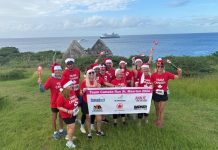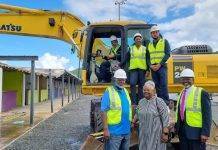GREAT BAY – NAGICO Insurances is advising their clients and the community to exercise caution and be prepared for the 2016 Atlantic Hurricane Season, which is June 1 to November 30.
This warning comes on the heels of an advisory issued by the National Oceanic and Atmospheric Administration (NOAA), that this hurricane season, is expected to be the most active one in the past 5 years.
“We are urging everyone, our clients and the community on a whole to begin preparations for this hurricane season while the skies are now clear because all indications from the meteorological offices show that this 2016 hurricane season will be very active and above average,” Marketing Manager of NAGICO Insurances Lisa Brown cautioned.
“Once you reside in an area where hurricanes or storms are a threat, you should be prepared every hurricane season, regardless of how long it’s been since we have been affected or hit directly by a storm. Remember, it only takes one storm to turn any hurricane season into a disaster,” she continued.
The NOAA predicts a 70 percent likelihood of at least 11 more named storms (we have already seen the development of Alex back in January), 8 of those storms becoming hurricanes and 3 of those hurricanes becoming major hurricanes – that is; a category 3, 4 or 5, with winds of 111 mph or greater.
“You have an opportunity now to actively take preparedness measures, if you have not already done so, because your actions or inactions now could mean the difference of life and death in the event of a major disaster,” she stated.
She also noted that NAGICO Insurances has made it a priority to create awareness and to keep their clients updated on any weather changes during the season. “We are also urging our clients to check their policies to ensure that they are active and have sufficient coverage. For more information or questions about your policies, do not hesitate to contact our local branch office or any of our agents or brokers island wide,” she concluded.
Some easy preparedness actions include: Make a kit. An emergency supply kit should include items as nonperishable food, water, a battery-powered or hand-crank radio, extra flashlights and batteries. Persons may also want to prepare a portable kit and keep it in the car.
Make a family emergency plan. The family may not be together when disaster strikes, so it is important to know how to contact one another, how they will get back together and what to do in case of an emergency. Plan places where the family will meet, both within and outside of the immediate neighborhood. Inquire about emergency shelters in the event you are not at home, but at places where your family spends time: work, daycare or school.
Have some cash on hand. In the aftermath of a hurricane the power might be out for several days. ATMs need electricity to run, so if the power is out, so is the money.
Evacuation Plan: If you have to evacuate, decide now where you would go. Identify several places you could go in an emergency, a friend’s home or public shelter. If you do not have a car, plan alternate means of evacuating. If you have a car, keep at least a half tank of gas in it at all times in case you need to evacuate.
Keep your documents safe: Ensure that all important documents like, birth certificates, insurance policies, etc., are kept in a safe place and are secured in waterproof container.
Clean up: Take care of your home and your surroundings. Clean drains, trim trees that may cause damage in the event of strong winds or heavy rains.
For more safety tips visit website www.nagico.com.





























